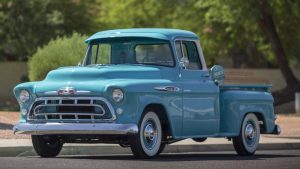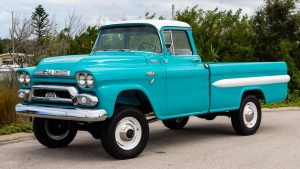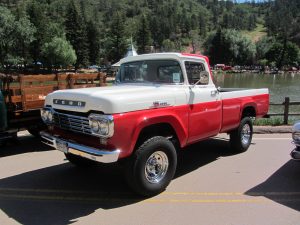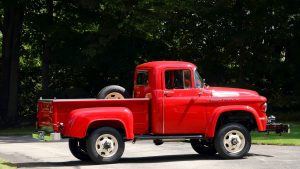These 3 light-duty ’50s trucks broke ground on four-wheel drive
Today’s drivers seem to think they “need” four-wheel drive or all-wheel drive, even if they live in a town where it snows once every five years and in which a gravel driveway qualifies as tough terrain. As for pickups, many ostensibly utilitarian examples on the market today pack as much leather and luxury as a Mercedes-Benz. That wasn’t always the case, of course. For most of their history, pickups featured barebones interiors; their owners needed them to do work, not to get to work. Even four-wheel drive was a relatively rare feature, and not until the end of the 1950s did each of the Big Three build its own light-duty 4×4.
By simply doing their jobs, most old-school trucks led a hard life in-period, which led to a low survival rate. This helps enhance vintage trucks’ desirability, and 4×4 examples in particular are typically worth significantly more than their rear-drive counterparts. With the current popularity of all-wheel drive in new vehicles, it makes sense that early 4x4s are coming into fashion, and these late-’50s pickups are just three examples.
1955–59 Chevrolet trucks

By 1955, Chevrolet’s postwar “Advance Design” trucks weren’t so advanced anymore, so GM replaced them with the “Task Force” line. Characterized by a wide egg-crate grille, hooded headlights, and a stylish wraparound windshield, Task Force trucks were available with the standard 235-cubic-inch six or the new small-block V-8.
Aside from the stylish Cameo Carrier with its two-tone paint and well-appointed interior, the majority of Task Force Chevys were work trucks. Nevertheless, “work truck” didn’t necessarily translate to four-wheel drive back then. Chevrolet would only build you one with rear-wheel drive—but if you really needed to conquer rough terrain, you weren’t totally out of luck. You could buy the “Powr-Pak” kit from the Northwestern Auto Parts Company (NAPCO) based in Minneapolis, Minnesota.

NAPCO did four-wheel drive conversions for Ford and Studebaker but is mostly known for its arrangement with GM in the second half of the 1950s. Available on both Chevrolet and GMC light-duty trucks, the NAPCO kit could be installed at the dealership in a few hours. By 1957, Chevrolet and GMC started installing the kits at the factory. However, NAPCOs were very expensive and never proved strong sellers, and with the introduction of the Chevrolet C/K series pickups in 1960, GM finally had a four-wheel drive system of its own. The conversion kits became obsolete.

These days, NAPCO-equipped pickups and Suburbans carry some notoriety in the collector truck world. An early dealer-equipped Chevrolet 3100, for example, carries a 40 percent premium over a comparable two-wheel drive truck in the Hagerty Price Guide. Well-restored, original NAPCOs have consistently brought big prices at auction. A 1957 3100 pickup sold last summer for $62,700, and two 1959 NAPCOs also sold in Scottsdale this year—one for $41,800 and one for $42,900.
1957–60 Ford F-Series

The third-generation Ford F-Series debuted in 1957 with distinguishing features like a clamshell hood, squared-off styling, a wraparound windshield, and an industry-first all-steel, full-width pickup box. The popular Styleside rear box features flat sides flush with the front of the body, though the traditional Flareside step-sided rear box was still available. Some called it a rolling refrigerator in-period, but today the model is recognized as a breakthrough in pickup design. Engine choices were either a standard 223-cu-in six or a 272-cu-in (later 292-cu-in) Y-block V-8.
As GM did with NAPCO, Ford outsourced four-wheel drive on its light duty trucks to a separate company called Marmon-Herrington for most of the 1950s. Ford beat GM to the punch with its own factory four-wheel-drive system, however, offering it for 1959 models. Four-wheel-drive F-100s from these years are still relatively rare, and they also definitely command a premium. For example, a 1959 F-100 Styleside Short Bed with a 292/160-hp V-8 is worth $15,000 in #2 (Excellent) condition, while the same truck in 4×4 configuration is worth 25 percent more.
1957–60 Dodge D/W Series
Virgil Exner’s famous “Forward Look” styling for Chrysler debuted on cars in 1955, but Forward Look cues extended to Chrysler’s pickup line in 1957. The Sweptside, Chrysler’s answer to the stylish Chevy Cameo, borrowed station-wagon rear fenders for a flashier look, while the better-selling Sweptline with a full-width, square bed debuted later. Underneath the now one-piece hood was either a 230-cu-in flathead six or an optional 315-cu-in (318-cu-in from 1959) V-8.
Although Dodge held a relatively tiny market share among light-duty pickups during the 1950s, it was ahead of both Chevy and Ford in offering four-wheel drive in a “regular” pickup (Dodge had sold civilian versions of the larger Power Wagon since 1946) starting in 1957. Dodge sold its first half-ton 4×4 pickup as the W100, and the rear-wheel-drive version as the D100. Confusingly, Dodge also used the “Power Wagon” name on the half-ton W100 as well as the larger one-ton Power Wagon.

Dodge trucks from the 1950s are much rarer than the equivalent Fords and Chevys and will stand out at most any show, but they follow the same pattern: 4x4s are much worth more than rear-wheel-drive examples. For example, while a 1960 D100 Sweptline with a 318/200-hp V-8 carries a #2 value of $24,800, the equivalent W100 is worth $40,400. A fully restored 1958 model even sold for $68,200 in Kissimmee three years ago.
Like this article? Check out Hagerty Insider, our e-magazine devoted to tracking trends in the collector car market.



Having had a W 100 1958 Dodge “Town and Country” suburban in mellow yellow to cover it’s SP’s R R work truck Orange track crew vehicle I know what a beast it was… not to leave things alone I took a 413 cu in with a torque flight tranny out of 1964 former CHP Polara sedan to replace the 251 flathead “6” with a four speed. The fact that it had 488/489 differentials didn’t help in the fuel economy dept. 12 x 16.5 rubber set it up well.